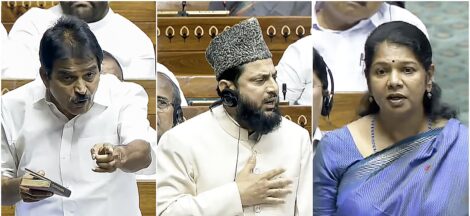Samajwadi Party chief Akhilesh Yadav may have been successful in bringing Om Prakash Rajbhar to the party fold, but the question remains whether Rajbhar will change the fortunes of the party in the upcoming 2022 Uttar Pradesh assembly election.
Experts said while the development was crucial in context to the upcoming polls, it was ultimately a gain for Akhilesh. The clout that Rajbhar’s Suheldev Bharatiya Samaj Party (SBSP) enjoys in the Purvanchal region of the state needs to be explored, they said.
It is a common saying in the political circles of UP that whoever wins Purvanchal, forms the state government. In 2017, the BJP won 106 out of 156 assembly seats in 26 districts, SP got 85 seats in 2012, and BSP got over 70 seats in 2007 – all from Purvanchal. This is the reason why the BJP is holding many of its programmes in Purvanchal. Prime Minister Narendra Modi has also conducted many tours in the region.
In the 2017 election, the BJP registered a big victory in Purvanchal as it won 106 seats from this region. Back then, the BJP was contesting the election in alliance with Rajbhar’s SBSP. But the situation has changed now. It will be interesting to see if Akhilesh is able get gain from this alliance.
Speaking to News18, veteran journalist and political commentator Ratan Mani Lal discussed the pros and cons of the alliance between Akhilesh-led SP and Rajbhar-led SBSP. “There is a general perception of non-Rajbhar people about OP Rajbhar that he may be a leader of the community but cannot be trusted politically. He had already announced his Bhagidari Morcha with PSPL (Pragatisheel Samajwadi Party-Lohiya), AIMIM and some other parties, but then he suddenly announced that he is going with the SP; this shows his fickle-mindedness. Rajbhar voters will look at a leadership that could give back something. This alliance has now given a signal to the Rajbhar community that their leader is with a strong party like Samajwadi Party, if not BJP.”
“I think if SBSP had continued in Bhagidari Morcha, Rajbhar’s political standing would have ended. Even if it indicates opportunism on his part, it can be called an intelligent move. The gains are certain for the Samajwadi Party; I am not sure what Rajbhar will gain. The SP can now rightfully claim that it has the support of a caste-based party, which has a strong leader and has come to the SP voluntarily,” said Lal.
Taking a look at data available, it is clear that smaller parties, when they contest alone, do not make much difference. Things, however, take a turn when they contest in alliance with bigger parties. In the 2012 election, the SBSP contested alone on 52 seats but did not win any.
But things changed for the party when it contested in alliance with the BJP during the 2017 election. Rajbhar understood that for a party whose vote share is more than 20 per cent is added to his, then victory will be assured. The BJP was also looking for a partner with 5,000 to 10,000 votes in every seat. By adopting this strategy, the alliance parties won many seats.
Rajbhar’s SBSP also won four seats with the support of the BJP. The vote share of the party increased from 5 per cent to 34 per cent in 2017. Hence, there is no denying SBSP’s role in the BJP’s historic victory in the Purvanchal region in 2017.
When SBSP and BJP parted ways, Akhilesh was quick to adopt the same strategy. In the 2017 election, out of eight seats the SBSP contested, the SP candidate stood second in three seats.
It seems Akhilesh has made a careful choice by bringing Rajbhar into the party fold, hopeful that the strategy will work in the Purvanchal region. Going by figures, in the 2012 election, on seats where the SBSP secured a good amount of votes, the SP stood second on those seats in 2017. In some seats, the SP’s 2017 ally Congress was at the second spot.
With inputs from News18




